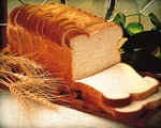12
Each break makes a quality of stock entirely different and distinct in itself which is purified and sent to different parts of the mill to be reduced into flour of varying grades. The reduction system starts with sizing the large middlings and taking a portion of flour from each grinding. This is kept up until the tail of the mill is reached and all the flour has been extracted. The rolls are different from the first-break rolls as they are smoother and a little closer together, but they move, like the break rolls, at different speeds. The bran does not break up, but flattens out and may be removed by passing the middlings over a fine bolting cloth that passes over the end of the reel. This flour contains small particles of bran and cannot be graded as high as the other flour. When the tail of the mill is reached, all that is left of the wheat is fit only for feed-stuff for animals.Every flour mill produces several different qualities of flour such as white, bran, and graham flour.
With increased transportation facilities, large mills began to replace the small country mills, for by reason of their large out-out, they could grind the wheat at much less cost. During the last half of the century, or perhaps for a longer time period, milling has come into the hands of large corporations.
The whole story of human existence can be written and told in the terms of mans staff of life – bread! Bread has been the mainstay of human diet for almost 6,000 years. However, the knowledge of people concerning this life giving food is very meager and inadequate. Not one person in a thousand realizes, knows, or understands what is contained in the food upon which he leans heavily and of which he consumes large quantities, not only every day, but in most cases, at every meal.
